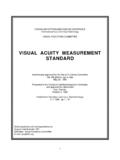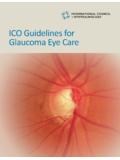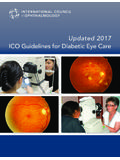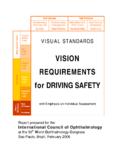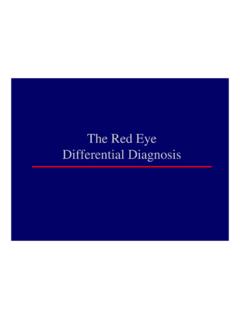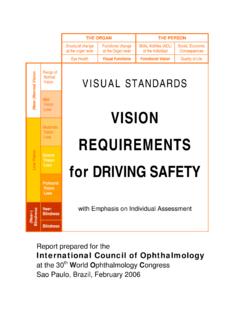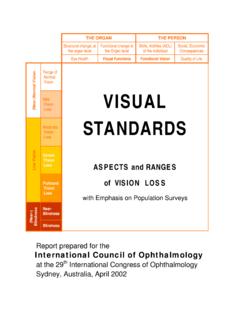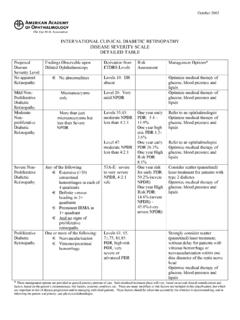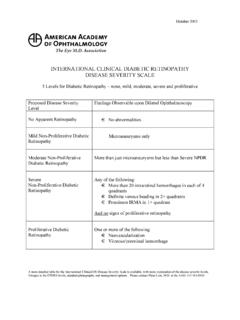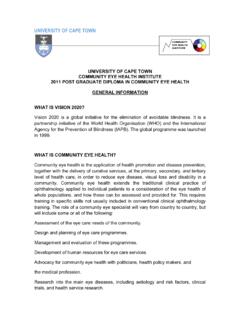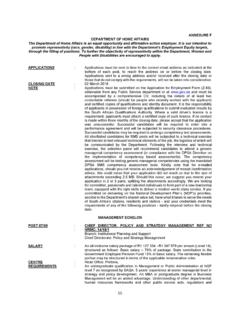Transcription of Diabetic Retinopathy Guidelines - International …
1 1 The Royal College of Ophthalmologists Diabetic Retinopathy Guidelines December 2012 Scientific Department The Royal College of Ophthalmologists 17 Cornwall Terrace Regent s Park London NW1 4QW Telephone: 020 7935 0702 Facsimile: 020 7487 4674 The Royal College of Ophthalmologists 2012 All rights reserved For permission to reproduce any of the content contained herein please contact 2 DR Guidelines Expert Working Party Members: Chair: Mr Faruque Ghanchi, Bradford Teaching Hospitals, Bradford Members: Miss Clare Bailey, Bristol Eye Hospital, Bristol Professor Usha Chakravarthy, Royal Hospitals, Belfast Dr Sue Cohen, QA Director, NHS Diabetic Eye Screening Programme, Gloucester Professor Paul Dodson, Birmingham Heartlands Hospital, Birmingham Professor Jon Gibson, Birmingham Heartlands Hospital, Birmingham Ms Geeta Menon, Frimley Park Hospital, Surrey Mr Mahi Muqit, Manchester Royal Eye Hospital, Manchester Miss Rachel Pilling, Bradford Teaching Hospitals, Bradford Dr John Olson, Aberdeen Royal Infirmary, Aberdeen Mr Som Prasad, Arrowe Park Hospital, Wirral Professor Peter Scanlon.
2 Cheltenham General Hospital, Cheltenham Professor Paulo Stanga, Manchester Royal Eye Hospital, Manchester Ms Gilli Vafidis, Central Middlesex Hospital, London Dr Alex Wright, Birmingham Hearlands Hospital, Birmingham Dr William Wykes, Southern General Hospital, Glasgow External reviewer: Dr Lloyd Paul Aiello, , Ph. D, Boston, Masachusetts, USA. Declarations of Interest: The Chair (FG) and authors (CB, UC, JG, GM, PS, WW) have declared receipt of educational grants from Allergan, Bauch & Lomb, Novartis, and associated with consultancy work for Allergan, Alimera, Bayer, and Novartis.
3 AW has received educational grants from NovoNordisk and Takeda and consultant fee from Novartis. JG has received travel grants to attend meetings and honoraria to attend advisory boards from Novartis, Pfizer, Bayer Healthcare, Allergan and Alimera (FG). No commercial interest was declared. 3 Preface Since the previous edition of the Royal College of Ophthalmologists Diabetic Retinopathy Guidelines , population based digital image photographic DR screening programmes have become established throughout the United Kingdom. A number of clinical studies have expanded the understanding of the condition and management of DR.
4 Similarly technological advances in retinal imaging especially the high definition OCT scans, wide field retinal angiography and new laser technology using multispot and micropulse abilities have widened clinical knowledge and treatment options. Medical interventions systemic as well as ocular have revolutionised the way Diabetic patients are managed in the eye clinics. The new Guidelines reflect on all these changes and aim to provide up to date guidance for busy clinicians. These Guidelines will be kept up to date with on line updates of major developments in the field. The aim of the Guidelines is to provide evidence-based, clinical guidance for the best management of different aspects of Diabetic eye disease.
5 The foundations of the Guidelines are based on evidence taken form the literature and published trials of therapies as well as consensus opinion of a representative expert panel convened by the Royal College of Ophthalmologists with an interest in this condition. The scope of the Guidelines is limited to management of Diabetic Retinopathy with special focus on sight threatening Retinopathy . It offers guidance regarding service set up to facilitate delivery of optimal clinical care for patients with Retinopathy . The Guidelines are prepared primarily for ophthalmologists, however they are relevant to other healthcare professionals, service providers and commissioning organisations as well as patient groups.
6 The Guidelines do not cover rare, complex, complicated or unusual cases. It is recommended that readers refer to other relevant sources of information such as summaries of product characteristics (SPCs) for pharmaceutical products as well as NICE and GMC guidance. The new Guidelines incorporate established and applicable information and guidance from the previous version with revision while some chapters are extensively revised and some new chapters are added. As stated in the previous version, the Guidelines are advisory and are not intended as a set of rigid rules, since individual patients require tailored treatment for their particular condition.
7 However, it is hoped that if used appropriately, the Guidelines will lead to a uniformly high standard of management of patients with Diabetic Retinopathy . 4 Search Strategy: Medline was used by individual authors of each section using search terms relevant to subject mater voered in the chapter, scanning the database for duration up to 2011. Previous edition of the RCOphth Guidelines were used as reference source. EVIDENCE is graded on three levels: Level 1: evidence based on results of randomised controlled trials (RCTS) power calculations or other recognised means to determine statistical validity of the conclusion.
8 Level 2: evidence based on results of case studies, case series or other non-randomise prospective or retrospective analysis of patient data. Level 3: evidence based on expert opinion, consensus opinion or current recognised standard of care criteria where no formal case series analysis was available. RECOMMENDATIONS for practice are based on treatment protocols and measures which were recognised to improve patient care and/or quality of life based on: Level A: where strength of evidence was universally agreed Level B: where the probability of benefit to the patient outweighed the risks Level C: where it was recognised that there was difference of opinion as to the likely benefit to the patient and decision to treat would be based after discussion with the patient Review Date: December 2015 5 Index Section 1.
9 Terminology and disease definition 6 Section 2: Epidemiology of diabetes and Diabetic Retinopathy 13 Section 3: Diabetic Retinopathy in children and adolescents with diabetes mellitus 24 Section 4: Diabetic eye disease in people with learning disabilities 32 Section 5: The public health aspects of Diabetic Retinopathy 34 Section 6: Management of diabetes and Retinopathy 42 Section 7: Clinical features of Diabetic Retinopathy 54 Section 8: Screening for Diabetic Retinopathy 64 Section 9: Retinal lasers 71 Section 10: Management of Diabetic Retinopathy 82 Section 11: Management of Diabetic maculopathy 96 Section 12: Vitrectomy in Diabetic eye disease 118 Section 13: Cataract in diabetes 130 Section 14: Commissioning for Diabetic Retinopathy 136 Section 15: Research 143 6 SECTION 1.
10 TERMINOLOGY AND DISEASE DEFINITION Diabetes mellitus is defined as a metabolic disorder of multiple aetiologies characterised by chronic hyperglycaemia with disturbances of carbohydrate, protein and fat metabolism resulting from defects in insulin secretion, insulin action, or both1. DEFINITION OF Diabetic Retinopathy Diabetic Retinopathy is a chronic progressive, potentially sight-threatening disease of the retinal microvasculature associated with the prolonged hyperglycaemia and other conditions linked to diabetes mellitus such as hypertension. CLASSIFICATION OF Diabetic Retinopathy Diabetic Retinopathy is a potentially blinding disease in which the threat to sight comes through two main routes: growth of new vessels leading to intraocular haemorrhage and possible retinal detachment with profound global sight loss, and localised damage to the macula / fovea of the eye with loss of central visual acuity.
